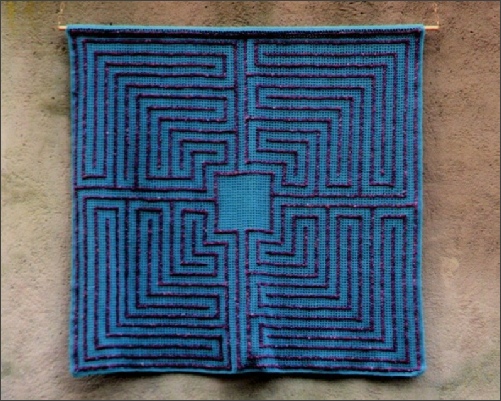




We started to become very fond of crochet grids as our ‘blanket canvas’ to work on.
This one is a progression from those we made for Spacecraft and Square Snowflake.
They were both very open, in order to show the curves clearly. Here we wanted to
show the walls of yet another maze. After our experiences during MathsYear2000, and
watching visually impaired children we wanted this to be a visual and tactile experience.
The colours are not essentially childish but they are strongly contrasting. The background
is turquoise-
The squares of the grid are much smaller than before so there are far more of them to cover the same area. The background takes a long time to make and gets rather monotonous but the speed of applying the walls compensates for this.
The walls look straight but actually zig-
Give Me a Clew is based on a reconstruction drawing from The British Maze Guide by Adrian Fisher and Jeff Saward. It is of a Roman maze discovered in Wales.
This type of maze is known as a labyrinth. It has one meandering pathway which leads from the entrance to the centre. This is a unicursal (one pathway) maze. Mazes using the same basic design are found in many parts of the world but their origin and purpose still remain a mystery, though many theories exist.
The afghan got its name when we discovered that a clew is ‘a thread to guide a person in a labyrinth, like that given by Ariadne to Theseus to guide him back through the labyrinth at Crete’
The four mazes we now had lent themselves to being grouped together. In addition to the small booklets we produced for individual afghans, we put them together in a larger book, called Maisie’s Mazes, along with mazes on a cushion and plastic canvas, and advice on how to adapt other mazes.
